Invisalign – Beverly, MA
Get a Straight Smile with Clear Aligners
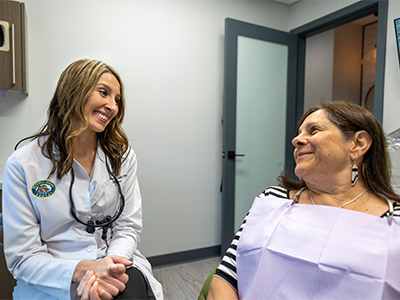
If you didn’t have braces as a child, you may feel you missed your opportunity to get a straight smile. Metal braces can cause a juvenile-like appearance that doesn’t match your lifestyle. You’re not out of options. Now, 1 in 5 orthodontic patients is over the age of 18 because of less noticeable treatments, like Invisalign. The clear aligners are the ideal solution for teens and adults who want to discreetly correct their bite and alignment concerns. Beverly Farms Dental can create the healthy, beautiful smile you have always wanted.
Benefits of a Straight Smile
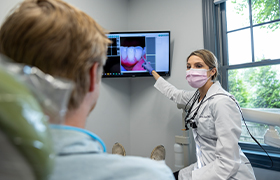
A straight smile is important for more than just your self-esteem. In fact, the alignment of your teeth also impacts your oral health and your quality of life. Your teeth are harder to clean when they aren’t in their proper positions. This increases your risk of tooth decay and gum disease.
Alignment issues can also lead to an uneven bite, which can impact your speech, chewing, biting, and other oral functions. It can cause uneven wear on your teeth, increasing the risk of a broken or fractured tooth over time. You even have a heightened risk of a knocked-out, broken, or dislodged tooth if you experience trauma to the face or mouth.
Invisalign can move your teeth into their correct positions to not only invest in your confidence but also your oral health.
Benefits of Invisalign
Invisalign is an FDA-approved orthodontic system that uses clear aligners to move the teeth instead of brackets and wires. The nearly invisible solution is a leading reason over 1.4 million people have chosen Invisalign to transform their smiles. Overall, you experience several benefits not possible with traditional braces, including:
- Sophisticated and discreet solution.
- Effective for correcting several bite and alignment issues.
- No dietary restrictions because the aligners are removable.
- Less time in the dental chair because you do not need adjustments.
- Easy oral hygiene routine and aligner care.
- Results in less time than metal braces.
Who Can Invisalign Help?
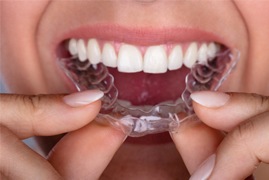
Although Invisalign can fix several issues, you still need a consultation to ensure it is the right treatment for you. That way, we can assess the complexity of your case and make sure your smile is decay and infection-free. With all of that said, Invisalign has helped patients with the following orthodontic problems:
Crowded Teeth
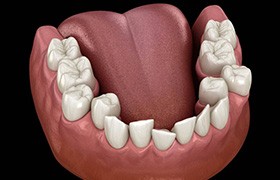
Overcrowding is one of the most common orthodontic problems, and, like the other problems on this list, it can negatively impact the look, health, and function of your smile. So, if your teeth are overlapped or crooked, it’s worth scheduling an appointment with us to see if you’re a candidate for Invisalign. That way, we can have a custom series of aligners made that move your teeth from where they are now to their ideal positions.
Gaps Between Teeth
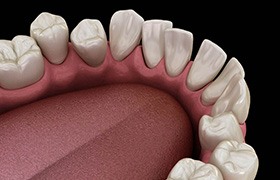
On the opposite end of the spectrum, maybe there is too much room, resulting in considerable gaps between your teeth. Unfortunately, this can also increase your risk of developing gum disease and other oral health problems. That’s why we recommend exploring your orthodontic treatment options. If you’re a candidate for Invisalign, then we will use the clear aligners to gently close the spaces and improve the alignment of your teeth.
Overbite
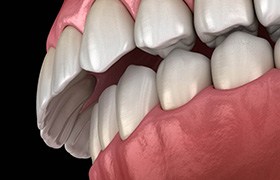
An overbite doesn’t always necessitate orthodontic treatment since it’s normal for your top teeth to sit in front of your bottom ones. With that said, a pronounced overbite can negatively impact your self-esteem as well as the health and function of your smile. To prevent chronic jaw pain, issues with your speech, and premature wear and tear on your teeth, we recommend finding out if you’re a candidate for Invisalign.
Underbite
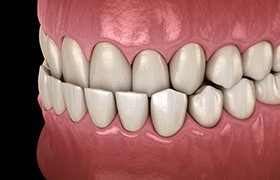
If your bottom teeth jut out beyond your upper ones, then you have an underbite. If you struggle with this bite problem, then you know all too well how difficult it can be to smile confidently, enunciate clearly, and chew correctly. The good news is that you may be a candidate for clear aligner treatment. With the help of orthodontic accessories, like rubber bands, we can improve the alignment of your bite as well as the alignment of your teeth.
Crossbite
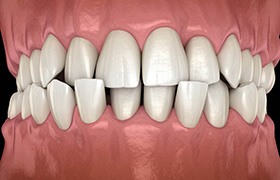
A crossbite is a combination of the previously mentioned orthodontic issues: where some of your upper teeth protrude beyond your lower ones and vice versa. Like the rest, this bite problem can result in trouble chewing properly, premature wear and tear on your teeth, jaw pain, and low self-esteem. In some cases, clear aligners can move your upper and lower teeth into their properly aligned positions, making your crossbite a thing of the past.
Open Bite
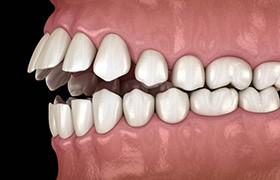
Open bites often form due to genetics or thumb-sucking. In this case, either your front or back teeth don’t come together evenly, resulting in an uneven distribution of pressure. To prevent that from continuing, you should schedule an appointment to see if you’re a candidate for Invisalign. If you are, then you can watch your teeth straighten and your bite align right before your eyes!
Invisalign Treatment Timeline
During your initial consultation, a 3D impression of your mouth is taken, which integrates with advanced technology. We map the movement of your teeth and transfer the information to a series of custom-made clear aligners.
You must wear your aligners for at least 22 hours per day. Each aligner is worn for 1 to 2 weeks depending on your individual treatment plan. On average, it takes 12 months to finish the series, but the duration of your treatment depends on the complexity of your case. After you finish the series, you need a retainer to maintain your results.
Understanding the Cost of Invisalign
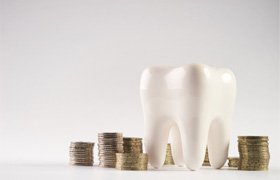
You may well want clear aligners for your teeth. After all, they could give you the straight smile of your dreams! Still, perhaps the cost of Invisalign worries you. Might the trays “break the bank” and exceed your budget? Well, the reality is that Invisalign’s price varies by patient. You'd need to consult our team for an exact treatment estimate. Thankfully, we at Beverly Farms will guide you through the financial details. To learn about them, just keep reading or call our office for the scoop.
Factors That Affect the Cost of Invisalign
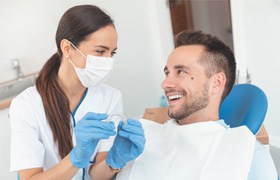
Once they give you an oral exam, our dentists will assess the factors impacting your Invisalign price. The most common of these include:
- The Treated Arches – Invisalign typically treats both arches, but not always. So, its price will partly depend on whether you’re straightening one or two rows of teeth.
- Needed Tooth Movements – The more complex your tooth misalignments, the more your Invisalign journey will cost. For instance, fixing a front tooth gap isn’t as pricey as treating several crooked chompers.
- Proposed Treatment Length – As you’d expect, a prolonged treatment is more expensive than a short one. The former requires paying for extra aligners.
- Your Compliance – You’ll face treatment delays if you don’t comply with Invisalign's best practices. Namely, the aligners won’t work without staying on your teeth for 22 hours daily.
We’ll only have an idea of how much your treatment will cost once we have developed a potential treatment plan. Our team will make sure that you’re aware of the various factors influencing the price so that you can get the care your smile deserves without worrying about any financial surprises.
Invisalign vs. Smile Direct Club™: Which Costs More?
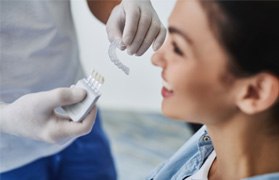
Admittedly, Invisalign is more expensive upfront than Smile Direct Club™. The former charges $3,000 to $8,000, while the latter costs just under $2,000. As a “quick fix,” then, Smile Direct Club™ can seem like the better option.
Remember, though, that Smile Direct Club™ is a “do it yourself” aligner kit. It has little-to-no professional oversight and leaves plenty of room for error. As such, you could make its dental impressions incorrectly or make a mistake in the treatment process. Such scenarios would lead to severe issues for your smile that need professional help anyway.
On the other hand, Invisalign would avoid these sorts of hurdles. It provides trusted oversight from our dental team at every step. You’d thus be guaranteed high-grade impressions and a smoother, more successful treatment. Given this peace of mind from a quality cosmetic service, the cost is worth it.
Does Dental Insurance Cover Invisalign?

Unfortunately, only some dental plans cover orthodontic work. Even among those that do, Invisalign is often left out.
Of course, there are exceptions! The occasional policy will cover up to 50% of the aligner treatment’s cost. Therefore, check your plan’s benefits with your dental insurance company. Our team can even help if you need assistance with that process.
Options for Making Invisalign Affordable
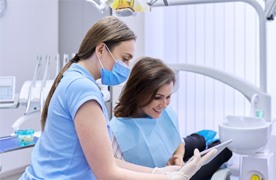
That said, dental insurance isn’t the only way to make Invisalign affordable. Many dental practices have alternative payment options.
For example, consider us at Beverly Farms. Our office works with CareCredit, which lets patients pay for care in low-interest, monthly installments. That approach would allow you to cover Invisalign’s cost gradually instead of all at once.
The Beverly Farms team is ready and eager to straighten your smile, all while keeping costs in-budget. That being the case, book a visit with our office to learn more about this financing!
Invisalign FAQs

Because of Invisalign, you no longer need to be sporting metal brackets and wires on your teeth until you get the results you’re looking for. However, you want to be well-informed about the treatment before committing to it. Here are the answers to some of the most common questions we receive about Invisalign. If you don’t see your question listed below, don’t worry. We’d be happy to get you the information you’re looking for and get you set up for a consultation. Just give us a call!
How Long Does Invisalign Take?
There are numerous factors that contribute to the time it takes to complete the Invisalign process. This includes the severity of your misalignment at how committed you are to your treatment plan. Generally, it takes between 12 and 18 months to complete your Invisalign treatment, but in cases where misalignment is very mild, it can be completed in as little as 6 months. While 18 months seems like a long time, this is still 4 months shorter than the average treatment time with traditional braces. Regular dental visits combined with your own commitment to the instructions will allow you to complete your Invisalign treatment more efficiently.
Does Invisalign Hurt?
Invisalign isn’t painful. Because of its smooth plastic design, it is actually one of the most comfortable treatment options out there. When you first get Invisalign, there’s an adjustment period where you may experience some soreness or discomfort that some might categorize as pain, but this will subside shortly. Invisalign works by gradually shifting your teeth into proper alignment by using a series of aligners. Every time you switch to the next aligner in the series, you may experience a small amount of pressure, but that just means it’s working! To reduce any discomfort, try taking over-the-counter pain medication and a cold compress.
Can You Eat with Invisalign?
One of the main advantages of Invisalign is that they are removable. This means that you can take them out when the time comes to eat. Eating when you have Invisalign doesn’t just cause cracks and stains, but it also puts unnecessary pressure on your teeth. The only thing you should be consuming while wearing your Invisalign is water. If you’re having anything else, you should take them out beforehand.
Who Is a Candidate for Invisalign?
When deciding whether or not Invisalign is a good option for a patient, there are a few different factors to consider, age being the most important. The jaw and teeth are constantly changing and growing from childhood to teenage years. Most teenagers, starting at 13, and adults are candidates for Invisalign treatment. Another factor to consider is commitment and responsibility. Patients need to wear their aligners for at least 20 hours a day in order to achieve the desired results. Patients who are younger or less responsible may want to consider traditional braces because they are fixed to the smile, therefore lower maintenance. The last factor is the severity of misalignment. Some bite issues are simply too complex to be treated with Invisalign and require traditional orthodontic treatment.
What Should I Do If I Broke an Aligner?
If one of your aligners break (even if the damage is relatively minor), then you should call our Beverly dental team ASAP. Once we take a look at your treatment plan and learn more about what happened, we will be able to determine what the next best step is. For example, we may recommend wearing your previous trays until a replacement arrives. Or, we may have you move onto your next aligners in the series if you only had a day or two left of wearing the now-broken ones.
Can You Drink Coffee with Invisalign?
Although you can’t drink coffee with your aligners in, you can drink coffee after you remove them! Since meeting the 20-22 hour-a-day wear time is essential, we encourage patients to indulge in this caffeinated beverage alongside their breakfast or lunch. To prevent staining and tooth decay, rinse your mouth thoroughly with water afterward and brush your teeth about 15 minutes later.
How Do I Clean My Invisalign Aligners?
You only need two tools to effectively clean your aligners: a soft-bristled toothbrush and clean, lukewarm water. Of course, you also need to take additional measures to prevent your aligners from staining, like not drinking coffee with them in and maintaining a solid oral hygiene regimen.
Note: if your aligners do turn yellow, don’t soak them in mouthwash or use a denture cleaner. Instead, dissolve a packet of Invisalign cleaning crystals in some lukewarm water. Then, submerge your trays in the mixture and allow them to soak for about 15 minutes.
Will Invisalign Give Me a Lisp?
It’s common for prospective patients to be worried about developing a lisp. However, the large majority of patients don’t experience any changes to their speech. The small number that do can have peace of mind knowing that it’s temporary. Furthermore, it’s likely so minor that your friends and family won’t notice a difference. Remember, Invisalign wouldn’t be one of the most sought-after teeth-straightening treatments with more than 14 million patients around the globe if it resulted in a long-lasting lisp!
What Happens After Invisalign?
Orthodontic relapse is when your teeth begin to drift out of their perfectly aligned positions. It’s currently estimated that roughly 50% of patients experience this phenomenon within a decade of completing their orthodontic treatment, which is why professionals now recommend wearing your retainers for more than a year or two. Instead, you should make wearing it nightly a life-long habit – it’s one of the best ways to preserve your investment and your beautiful smile!
What Are Invisalign Attachments?
When patients hear “Invisalign,” they often think of the discreet, see-through trays. However, many patients need attachments as well, which are little pieces of tooth-colored material that are bonded to the front-facing surface of your teeth. Simply put, they give your aligners something to grip onto, which ensures more moderate cases of malocclusion are addressed effectively. Having the attachments placed is relatively quick, and having them removed is painless and doesn’t damage your enamel!

